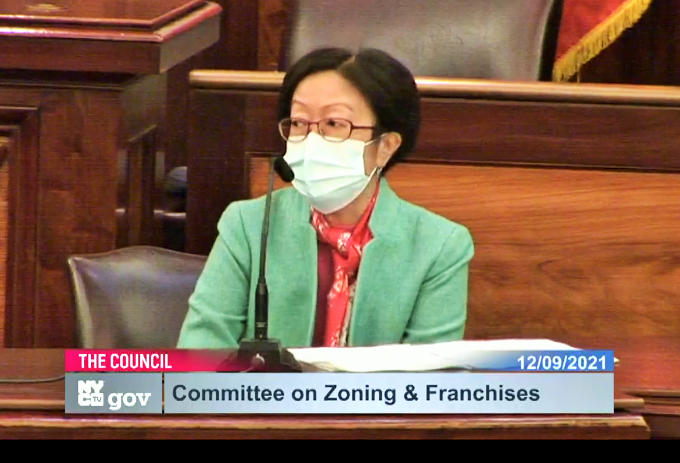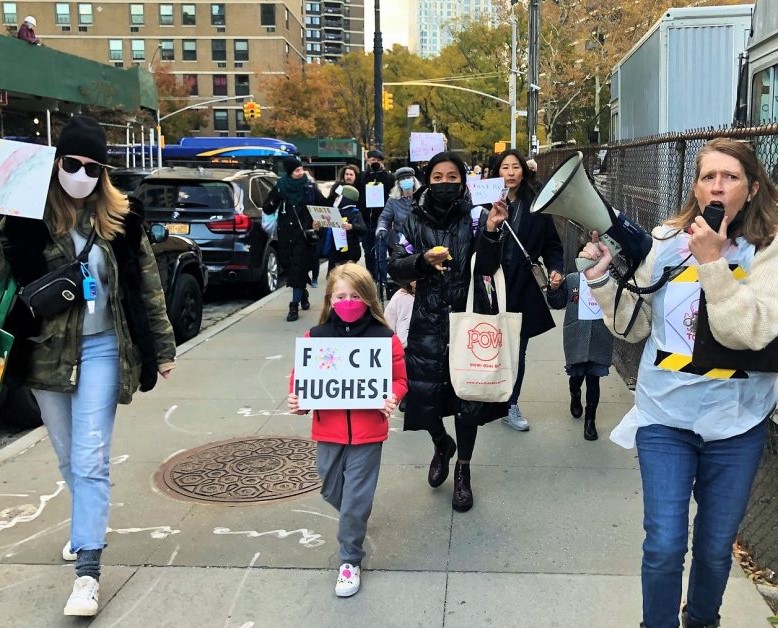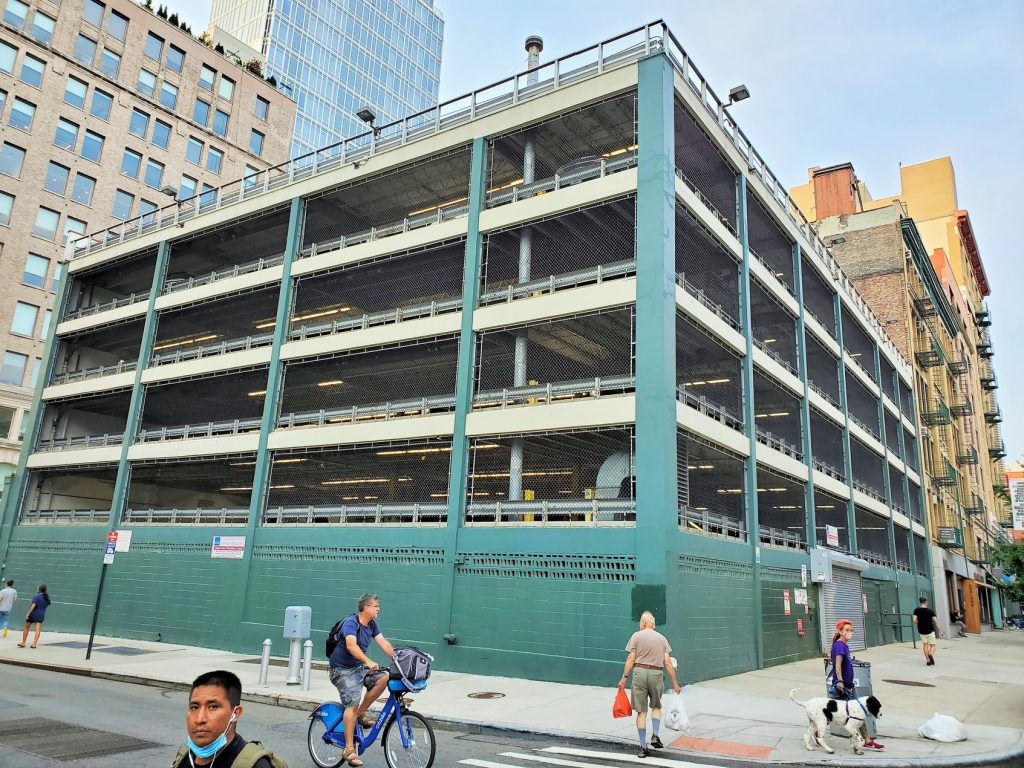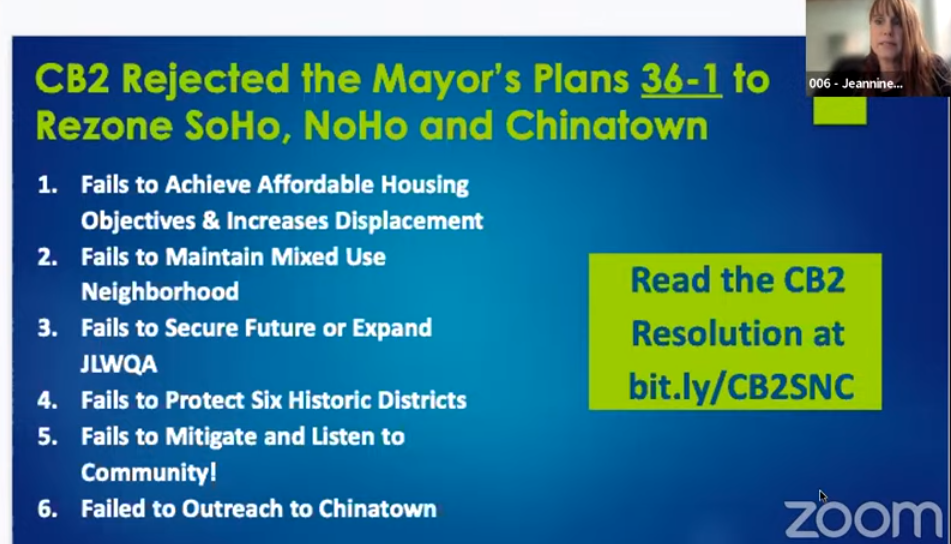BY LINCOLN ANDERSON | Updated Fri., Dec. 10, 11:30 a.m.: Margaret Chin said she hopes the Soho/Noho rezoning will lead to affordable housing being built. Carlina Rivera said the scheme has been tweaked to push developers to build affordable housing.
But there is still no guaranteed affordable housing in the contentious upzoning plan, which passed two key City Council votes on Thursday.
The two councilmembers spoke before the Subcommittee on Zoning and Franchises unanimously voted to approve the hot-button rezoning. Shortly afterward, the Council’s Land Use Committee also rubber-stamped the plan, save for a lone dissenting vote by Inez Barron.
But critics of the scheme reiterated that it still contains no assurance that any affordable units will be built in the two coveted Downtown enclaves. Opponents charge the rezoning is “developer-driven,” with large loopholes that will allow developers to dodge creating affordable housing, such as if they simply build less than 25,000 square feet per lot.
In fact, according to a recent financial analysis by Village Preservation of one prime site in the rezoning area — the Edison parking lot at 375 Grand St. / 30 Great Jones St. — the property owner could reap twice as much by developing it with 100 percent market-rate housing versus including affordable housing.
‘Misinformation and scare tactics’
Rivera, in particular, though, accusingly pushed back against the critics.
“It’s no secret,” she said, “that this process was plagued by roadblocks from private interests, a tight timeline, misinformation and scare tactics.”
The Soho/Noho rezoning next moves on to the full City Council for a vote next week, after which the mayor will sign it into law. If the plan is approved, it would be the first time in New York City’s history that a designated historic district would be upzoned — possibly serving as a blueprint for similar upzonings in the future.

Chin on Thursday — in an apparent effort to put a positive spin on the Soho/Noho rezoning through association — mentioned two other Downtown projects that are actually outside of the rezoning area that she said would include affordable housing. As well as outside the district, one of them also came from out of left field.
Affordable housing — in Hudson Square
In a surprise announcement, Chin said the city would build 100 units of affordable housing on a vacant lot in Hudson Square at Hudson and Clarkson Streets that is above a water-tunnel shaft and under jurisdiction of the Department of Environmental Protection. For years, Community Board 2 and others have pushed this spot as an alternative site for affordable housing, in hopes that Chin would drop her determined plan for the Haven Green housing project, so that the Elizabeth Street Garden could be saved.
Chin said the city “will be committed to do” the affordable housing development at the Hudson Street site “starting next year.”
However, C.B. 2 Chairperson Jeannine Kiely said the community board was not notified of this new plan before Chin sprung the news on Thursday.
(Ironically, C.B. 2 was not notified either years ago when Chin first earmarked the Elizabeth Street Garden for the Haven Green project. In fact, a similar M.O. had played out back then, as Chin, unable to get 100 percent affordable housing in the Seward Park redevelopment plan on the Lower East Side, unilaterally targeted the distant Elizabeth Street site for affordable units as a consolation.)
Little Italy garden still at risk
Joseph Reiver, the Little Italy garden’s executive director, was also blindsided by the news.
In a statement to The Village Sun, Reiver said, “We’ve been advocating that the city build affordable housing at 388 Hudson St. as an alternative to destroying Elizabeth Street Garden for years now. Up until now that solution has been neglected or denounced as not possible — but clearly it is possible to build at the site. As more information arises about the plans, we’ll see if the building will be 100 percent permanently low-income housing, as it should be.”
Reiver thinks actually more housing than the amount Chin cited could be built at the Hudson Street location.
“One hundred units seems like a low amount considering there is roughly 21,000 square feet (25,000 minus the 4,000-square-foot easement) and the possibility to rezone for more F.A.R.,” he noted. “Even so, this news only supports our position that we can achieve the needed affordable housing without destroying vital community green space.”
The city alerted the Elizabeth Street Garden in October that it was being evicted from the property. Reiver said the garden is currently fighting that order in Housing Court, in addition to separately litigating against the housing plan. In the meantime, the garden remains active, with a winter solstice event slated for Dec. 21.

Chin touts 250 Water St. project
In addition, Chin mentioned 250 Water St. — located a full mile away from the rezoning area — a development planned by Howard Hughes Corporation in the South Street Seaport Historic District, which she noted would have around 100 “deeply affordable” apartments. Opponents, though, protest that the project would be built on a toxic, mercury-laden site next to three schools and is inappropriately large for the historic district.
The Council subcommittee and committee also approved the 250 Water St. project on Thursday.
Pitching improvements to “open space” that the rezoning would bring, Chin cited sprucing up Sara D. Roosevelt Park, which is, again, not in Soho and Noho. Rivera echoed that long-standing concerns about open space in Soho and Noho would be “addressed significantly” by the plan, though didn’t state specifics.
J.L.W.Q.A. fines O.K.’d
Also Thursday, the subcommittee and committee approved, with zero discussion, a last-minute proposal by the term-limited Chin to steeply boost fines for nonartist residents in units zoned Joint Live Work Quarters for Artists (J.L.W.Q.A.) in Soho and Noho. At a recent C.B. 2 meeting, local residents angrily warned that, instead of a promised “pathway to legalization” for nonartist residents, the inceased fines would “tear apart buildings,” causing neighbors to rat each other out with 3-1-1 calls.
The Soho/Noho rezoning will allow residential development and retail use “as of right” in Soho and Noho, which both currently require special-permit applications. It will also upzone the area, especially in three “opportunity zones” where the most development is anticipated — including a corner of Chinatown that the plan misleadingly redubs “Soho East.”
The rezoning will also designate the area for Mandatory Inclusionary Housing — a program that, despite its name, is optional; developers can voluntarily choose to participate in M.I.H. or not, depending on the size of their projects.
F.A.R. reductions, no dorms
In addition, in one significant change announced Thursday, the Soho/Noho rezoning now will prohibit university dormitories. Also, large-scale retail stores of more than 25,000 square feet will need a special permit.
Chin and Rivera were short on specifics as they extolled the rezoning — although Rivera said she would go into more detail at a later point. Andrew Berman, the executive director of Village Preservation, confirmed that the final rezoning resolution approved Thursday, as modified by the City Council, does include new reductions in both commercial and residential F.A.R. But he stressed these changes would not have come about save for advocacy by Village Preservation and others. He also noted the newly added dormitory ban, something his group had also called for.
(F.A.R., or Floor Area Ratio, is a formula used to determine a building’s bulk based on the size of its lot.)
“The changes make the City Council version less bad than the City Planning Commission version,” Berman said. “But what they approved is still very, very bad and based upon lies, false projections and developer giveaways.”
A summary of the City Council’s modifications of the rezoning plan can be found here.
Chin’s Council District 1 covers most of the rezoning area.
In her remarks before the subcommittee vote, she said the process of working on the rezoning had been so “challenging” as to be “excruciating.”
‘Every neighborhood must contribute’
“It’s really time that we make sure every neighborhood in the city contributes to building affordable housing,” Chin stressed. “And a neighborhood like Soho/Noho, where it’s wealthy — we thought, rich — they need to also contribute an opportunity to create more affordable housing. At the same time, we will be able to help maintain the artistic character of this wonderful neighborhood.
“With the change in the zoning allowing residential [use], we hope that affordable housing will be built,” she offered.
Again, “hoping” for affordable housing is not the same as guaranteeing it. But Chin added that Deputy Mayor Vicki Been, the main archiect of the rezoning, had given a “commitment [to] really work with us to look for opportunity to build affordable housing.”

“Unfortunately, in this area there is not any kind of city-owned sites,” Chin said, before going on to mention the Hudson Street D.E.P. and 250 Water St. locations, which are, again, outside of the rezoning area. However, C.B. 2 has pitched the garage at 2 Howard St., which is federally owned, as a perfect spot for affordable housing. And a coalition of Lower Manhattan residents and local politicians are calling for 5 World Trade Center to be 100 percent affordable housing.
Impassioned defense of rezoning
Rivera’s District 2 part of the rezoning district, the northern end of Noho, is much smaller than Chin’s. However, showing how heavily invested she is in the plan’s passage, Rivera spoke longer, more passionately and in more detail about it than Chin did.
The Soho/Noho rezoning, Rivera said, “marks a critical change to the city’s historic practice of focusing neighborhood rezonings in communities of color, moving us toward a more equitable future where all neighborhoods contribute their fair share in our ongoing fight against the housing crisis facing New York City.”
Rivera said the “clear goal” — which she called the “north star” that she and Chin followed — in passing the rezoning was “to incentivize the creation of affordable housing at income levels where it is desperately needed.”
“The finished product is not perfect,” she conceded. “It can’t be — because the underlying mechanisms on affordability are themselves imperfect.”
Rivera said the rezoning represents “a rational framework for retail operation and housing generation in this high-value, transit-rich neighborhood.”
‘We reduced F.A.R. as much as possible’
The councilmember noted that she, like the community, had not been satisfied with the rezoning plan as it was initially presented, but that through “tough negotiations and rigorous review,” it had been improved. She added that “dorm and university usage” in the redistricting area had been “eliminated,” and that commercial F.A.R. has been “reduced as much as possible, in order to push developers toward [building] housing above all else.”
Rivera added that the rezoning will also include an “arts fund” for Downtown Manhattan, plus another fund for creation and preservation of housing, as well as “legal support” for area loft tenants. The arts fund would be financed by a new “flip tax” on sales of Joint Live Work Quarters for Artists-zoned apartments to nonartists — an idea that has met hot resistance from many Soho and Noho residents, who call it retroactive and “punitive.”
The lame-duck mayor had actually abandoned the Soho/Noho rezoning in February 2020, saying there was not enough time left to pass it in his final term, only to suddenly revive it in October 2020. The sweeping plan is now poised to pass with just two weeks left before de Blasio vacates City Hall.
Opponents deeply disappointed
Opponents who have tirelessly fought the rezoning over the past year — including in court — were bitterly disappointed by Thursday’s results. Sean Sweeney, the director of the Soho Alliance, accused Chin and Rivera of failing to represent the community’s residents.
“Our two councilmembers have yet again abandoned the people they are supposed to represent and have handed the real-estate industry most of the upzoning de Blasio offered his campaign donors,” Sweeney said.
“Moreover,” he said, “it would be humorous — were it not so sad — that the only giveaway that historically these two have offered Soho residents is a commitment to upgrade Sara Roosevelt Park on the Lower East Side, a park well over half a mile away from Soho, where a man was recently murdered and which is historcially known as a hot spot for drugs, homeless and prostitutes. Bet Soho moms can’t wait to bring Junior over there to collect the used hypodermic needles.
“Margaret Chin has neglected that park for the past 12 years,” Sweeney added. “Suddenly, in her last days in office, she sees the light and wants to improve it, using the upzoning of Soho as the scapegoat, continuing to divide neighborhoods even as she leaves office.”

C.B. 2 previously did its own analysis of the Soho/Noho rezoning, offering extensive recommendations on how to improve it. But the board’s input was snubbed by City Hall and not included in the plan.
C.B. 2 Chairperson Kiely said, “We are disappointed that the carefully researched and documented flaws in this upzoning plan were not addressed in any meaningful way.
“We welcome affordable housing,” she said, “but we remain concerned about displacement of low-income residents, including seniors aging in place and the demolition of their homes for lucrative luxury housing and commercial development.
“C.B. 2 will continue to fight for true affordability, tenant protections against harassment and quality-of-life improvements for all who live and work in our community.”
‘Plan will line developers’ pockets’
Village Preservation director Berman, in a statement, blasted what he called the “sham plan.”
“It is deeply unfortunate that several councilmembers voted to approve this sham plan, which will line the pockets of developers who donated generously to Mayor de Blasio,” Berman said. “Study after study showed that the plan is likely to produce little if any affordable housing, and is almost surgically designed to discourage the construction of affordable housing; the modifications made by the City Council will do little to change that.
“What it will do,” he said, “is create huge incentives for destroying hundreds of units of affordable, rent-regulated housing in the rezoning area, the majority of whose residents are lower income and disproportionately seniors, artists or Chinese immigrants. Welcome to the future, where huge developer windfalls equal social justice, and building oversized luxury condos, boutique office buildings, overpriced hotels and big-box international chain stores, as this plan encourages, is sold as promoting equality. Today, down officially became up, and night officially became day in New York City.”
Berman called it “shameful” that the City Council refused to heed respected housing and tenant advocates — including Michael McKee, the treasurer of Tenants PAC, Cooper Square Committee and Met Council on Housing — environmental groups, Chinatown leaders, anti-displacement advocates, C.B. 2, national preservation organizations and “tens of thousands” of New Yorkers who wrote, called and e-mailed the councilmembers to reject the plan.
“We wonder why there is so little faith in government,” he reflected, “especially local government, with its record low turnout for elections.”
Extensive information and analysis by Village Preservation on the rezoning’s impacts can be found by clicking here.
Correction: The original version of this article incorrectly stated that the City Council did not reduce commercial F.A.R. in the Soho/Noho rezoning plan beyond what the City Planning Commission had already previously done. In fact, the City Council, in its modifications of the plan, did make commercial F.A.R. reductions.


I am devastated by hearing the news about building at the Hudson Street site. “Affordable housing?” What a sham — and everyone knows it. Our politicians are not working for the people who voted for them — but for their real estate contributors. Thank you to Councilmember Inez Barron for speaking up. (I am impressed with her.)
We do not need more buildings here. What we need in this district is open & natural areas. They plan to make the southern part of the Hudson St. space a seating area, but once the building on the north side goes up there will be very little sunlight as all the buildings surrounding it will be tall, creating a concrete “well.” Shame on CB 2 for favoring special interests over the people it is supposed to represent by pushing for a building on the Hudson St. site.
There are plenty of buildings already up that can be converted to housing. Jumaane Williams even mentioned using existing buildings for affordable housing when he was campaigning for Public Advocate. What happened, Mr. Williams? Please step up now.
There should be a moratorium on building in this district, which has the least amount of natural areas and open space in the 5 boroughs. Save the Elizabeth Street Garden, too. We need a hero not only for those of us who live here now, but also for future residents.
See, I knew people would immediately turn on an affordable housing development at 388 Hudson as soon as it was announced! Even I didn’t think it would happen this quickly though. More permanently vacant lots is just what the city needs!
Who the h–l is LES? Why doesn’t he put his name on his written opinions? It seems so cowardly.
Les..you should stop. No one “took” anything. They bought their apt and made it their home. They paid to live here and they pay really high taxes like the rest of us… They bought from artists who chose to relocate.
And may I remind you because I’m certain you have heard this….. all nonconforming residents are not lawyers and bankers.. but dancers, photographers, architects and others in creative art fields but unfortunately they weren’t able to qualify as an “artist” by The City’s Cultural Affairs department’s narrow standards. Then by the mid-’80s very few if any felt it was necessary to apply…. Today I believe it’s against fair housing laws to exclude anyone from living anywhere… Why not stop focusing on the residents and think about the City’s free pass to all ground-floor illegal commercial owners? …Retail has only been legal on ground floors that have gone for special permits. Why do you think residents should be forced to pay to change their status but not commercial owners? Why do you judge residents who chose to settle in abandoned buildings and spend their own money to bring them up to code and yet not say a disparaging word about owners of commercial buildings, who inherited them or bought them for dirt cheap by today’s standards?
It’s just not true that any one paid “really high taxes.” City property taxes for owner-residents are far too low and out of balance with taxes renters have to pay (https://www.businessinsider.com/if-you-live-in-new-york-and-you-rent-youre-paying-a-huge-tax-you-dont-even-know-about-2013-6). If SoHo owners paid “high” taxes, it’s only because their apartments are wildly valuable, which means they should be paying high taxes.
LES or is it LESS? Once again you show pure ignorance.. I happen to be as legal as legal gets.
Then why do you think that illegal owners should get complete amnesty? If you’re a certified artist using your space as live-work (or family member of one), why do you think the bankers and lawyers and speculators who illegally took apartments that were meant for people like you and profited off the scarcity of housing shouldn’t face any consequence for that?
Rivera is a bridge-and-tunnel sellout. She puts people who don’t live in her district ahead of the interest of people who do live in her district. The bridge-and-tunnel people have their own Council reps in the districts where they live. Who represents people who live in New York?
There is something terribly wrong with the world we are living in, when thinly veiled lies are able to masquerade as truths and those who spout them don’t give a damn about who they hurt.
What is worst is that there are intelligent individuals, educated individuals, who listen to these lies and approve them.
Shame on Rivera, shame on the Land Use councilmembers…. approving a bad zoning plan just because the one in place is 50 years old. That train of thought is totally irrational and you should know better!!!
Approving enormous fines for residents because the Dept. of Buildings didn’t do their job over the last 40 years, that’s insane, punitive, vengeful. (Yet the City relied heavily on the high property taxes it received from these very same residents.)
This sham process was supposed to create a pathway for nonconforming residents to become legal.. but what it did instead was give all illegal ground-floor retail a free ride to “as of right” and gave room to oversized retailers to invade and destroy a world-renowned historic district.
Now, legal residents in legal buildings will be forced out of their forever homes because they may not be able to afford to pay the punitive conversion tax or respectfully need their savings,
Residents, mostly seniors, won’t be able to pass on the homes they have owned for decades to their nonartist children who were born there…. Many of these buildings can never meet the new codes, thus throwing their legal C of O’s out with the trash! as it will be structurally impossible to convert from manufacturing to residential.
How utterly despicable that those with the power to stand up and vote NO didn’t have the gall or fortitude to do so…
Just a simple change from JLWQA to JLWQ would have made all nonconforming residents legal and updating C of O’s a stress-less endeavor.
This de Blasio signature piece of legislature, this SHAM upzoning never EVER had anything to do with anything other than wiping the tears away from overleveraged developers that he and others were indebted to…so that they can continue to line the pockets of those seeking funds for their next political campaign.
Worst yet, take a serious look at all those developers who have and will be in the future be granted tax breaks…and remember that those millions came directly from the retirement funds and hard work of artists and residents within the SoHo / NoHo neighborhoods.
We took a gamble and developed an area that was abandoned and made it a neighborhood that tourists, shoppers and folks from all over the world want to come see..once lower buildings are demolished and modern, narrow skyscrapers stand in their place..let’s see how many movies and media companies will be interested in paying to film here… .
Make no mistake, the City officials who went along with this ill-conceived Plan, and bought into the BIG LIE, that it was all about equality, they themselves will be responsible for the displacement and harassment of rent-controlled and senior residents. Shame, Shame on all of you!
There was always a better Plan and you chose to not accept it. Why? Because it was proposed by Village PRESERVATION?!
Sure, the city could have let you get away with no consequences for living there illegally for so long and also let you keep all the land value appreciation that resulted from you exploiting the restrictive zoning there. But I’m glad they didn’t.
This is ridiculous.
First of all, narrow streets like Spring and Prince were laid out in the eighteenth century and were already amongst the most congested in Manhattan, even before the addition of outdoor restaurants, bikes and motor scooters.
There was affordable housing when I got here in 1974, and I was living in a car, but most folks didn’t consider the abandoned old factories to be housing at all, until we artists provided the sweat equity and vision that converted a despised and forgotten sector into a magnet for the wealthy. Now I am being sued by the nonartists in my building, and if they succeed in forcing me to sell our home at Public Auction, I will now have to pay a flip tax, for the honor of being evicted!
I suppose if I am forced out, I will be able to tip my cap on the way out to Rivera, and Chin, who have never lived here, but will have succeeded in destroying what is left of a once-beautiful artists’ district.
Thrilled that this got through. Great news for the city.
It’s not worth trying to correct all of Berman’s lies that are quoted here (he has been lying throughout this process, so why stop now), but there is one that stands out. He says “the dormitory ban was the main new change.” Other reporting, however, has said that the committee reduced commercial FAR in certain parts of the rezoning area from 10 to 5 (https://therealdeal.com/2021/12/09/city-council-tweaks-soho-rezoning-assuring-its-passage/). This is a big win for housing, since it encourages building housing over office buildings. It’s too bad some residential FAR was also reduced, but that seems like a smaller concession.
Also excited to read that 388 Hudson St. is going to move forward. Another great opportunity for housing. I will enjoy watching all of the same people who have been saying the city should build there instead of on Elizabeth Street find a reason to oppose whatever development is ultimately proposed.
If is is a great plan for “the city” as a whole, as you claim, it is lousy for the New York County part of “the city.” Manhattan is already badly overdeveloped. Rather than continuing to decrease the quality of life in Manhattan, de Blasio should have focused on increasing the quality of life in the city’s outer boroughs. But de Blasio hates Manhattan and this is part of his revenge on it. And Chin and Rivera put the interest of their own constituents last.
If you don’t like living in a city and think Manhattan is overdeveloped then you’re free to move to the suburbs. The rest of us like it here and want more people to have the opportunity to join us.
The old “if you don’t like it, move” ploy. Since you consider the area underdeveloped and inadequate as it is, why do you still live in NYC?
LES3025,
It’s always interesting when suburban transplants instruct native and longtime New Yorkers to move to the suburbs… .
You are the voice of corruption. Chin, de Blasio and their ilk will be imprisoned when their corruption is relieved.
Hi again, LES3025
I will repeat my other post (which you have commented on)
If the City and current elected officials had cared about affordable housing in NYC they would have taken action to:
Save low- and moderate-income areas from hyper-gentrification.
Save housing from Airbnb.
Not allowed warehousing and teardowns of tons of affordable units to be replaced by new luxury high-rises.
Saved Mitchell-Lama.
Fixed the thousands of NYCHA apartments that are vacant but need repair.
Fixed the thousands of occupied NYCHA apartments that need repair.
It seems relevant to remind of 2 significant examples –- the City allowed the teardown of 5 East Village residential buildings to make way for a hotel and allowed the Rivington House nursing home to go to a luxury developer.
It is like a person who murders their parents and seeks sympathy because they are an “orphan.”
Basically all this “affordable” housing is a luxury real estate “Trojan House.”
In addition, new SoHo/Chinatown development will just mean permanent gridlock on Canal Street, around the Holland Tunnel and the small streets of the surrounding areas. (The new rich residents will of course be getting lots of e-commerce/food delivery.)
I’ll give you the same reply, which is even more applicable to SoHo, and which you did not respond to:
How do you think low- and moderate-income areas get saved from gentrification? You build more housing for the would-be gentrifiers in fully gentrified, high-income areas so that they move there instead of to the gentrifying areas. If you care about gentrification (and I do), you need to support building more housing in rich areas like Lower Manhattan (including the Seaport and SoHo). And not just affordable housing, although it is important for that to be part of the plan, which it is here.
I will never defend the city’s management of NYCHA, but if your position is that we can’t permit any private development until the city fixes NYCHA, that’s a problem.
It’s absurd for Berman to try to take credit for the reduction in commercial zoning. Lowering commercial FAR to promote more residential development has been Open New York’s argument this entire time. There was reporting earlier this week that the push to reduce residential FAR and promote commercial development was being led by Berman’s allies, including “preservationists” at Cooper Square Committee. Open New York’s director was quoted as opposing this, and they mobilized people to push for reducing commercial FAR, which ultimately worked (https://therealdeal.com/2021/12/07/as-soho-rezoning-comes-to-head-housing-may-be-cut/).
Actually, it was not. Open New York was late to the table on that one. Very late. Not surprising because it’s not an analytical organization, just a neoliberal front for big real estate. Berman so deserves credit. He showed the truth of this zoning, using facts, not manipulations.